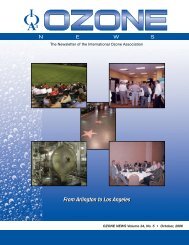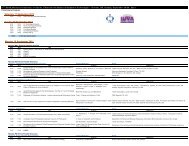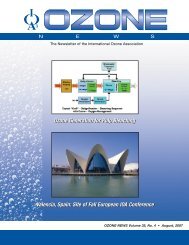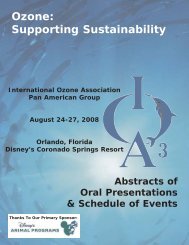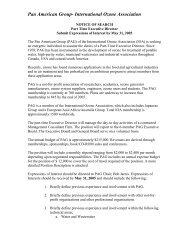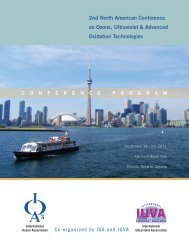Vol 33 No 4 Text - International Ozone Association
Vol 33 No 4 Text - International Ozone Association
Vol 33 No 4 Text - International Ozone Association
You also want an ePaper? Increase the reach of your titles
YUMPU automatically turns print PDFs into web optimized ePapers that Google loves.
<strong>Ozone</strong> News <strong>Vol</strong>ume <strong>33</strong>, <strong>No</strong>. 4<br />
• In February 2005, EPA published a contaminant list.<br />
Of specific emphasis are:<br />
• Lead – Regulation changes to be proposed in<br />
early 2006<br />
• Perchlorate – EPA is trying to determine whether<br />
to regulate. 26 states have found chlorate in excess of<br />
4 ppb.<br />
• MTBE – An advisory committee recommends a<br />
maximum limit of 20-40 ppb. A draft health<br />
assessment is being completed.<br />
• Arsenic rule. This rule was promulgated in 2001 and<br />
full compliance is required in some cases in early<br />
2006. EPA has held webcasts explaining the rule and<br />
is now conducting on-site workshops in Phoenix,<br />
Sacramento, Omaha, South Bend and Anchorage.<br />
These workshops provide information to users on<br />
technologies to remove Arsenic.<br />
A summary of the regulations and their compliance dates<br />
can be found at:<br />
www.epa.gov/safewater/regs.html<br />
Technical Sessions<br />
Industry News(cont’d)<br />
A number of technical presentations focused on ozone or<br />
related applications, a summary of which follows:<br />
J. Dan Shannon, CDM, discussed the expansion of the<br />
Fort Worth, TX Rolling Hills Water Plant from 160 to 200<br />
mgd capacity and the installation of a raw water<br />
ozonation facility. Ozonation was selected to meet current<br />
and future regulatory requirements, reduce tastes and<br />
odors, and improve overall treated water quality. Using<br />
LOX as the feed gas, the plant achieved 4.28 kwh/lb at<br />
10% ozone concentration. The sum of power and oxygen<br />
costs was $0.58/lb at this concentration.<br />
<strong>Ozone</strong>-enhanced biofiltration for geosmin and MIB<br />
removal was reviewed by Kerry Meyer, Carollo Engineers,<br />
and Debbie Metz, Greater Cincinnati Water Works. Pilot<br />
studies were made on the City of Boulder’s 63rd Street<br />
Water Treatment Plant and full-scale biofilter (pre GAC)<br />
tests were conducted at Cincinnati.<br />
There is increasing concern on the presence of<br />
pharmaceuticals and personal care products in drinking<br />
water. The effectiveness of treatment technologies in<br />
removing pharmaceuticals was reviewed by Shane Snyder,<br />
Page 10<br />
Southern Nevada Water Authority. <strong>Ozone</strong> is able to<br />
remove most of the products in question; byproduct<br />
formation still requires study. UV works on several<br />
products; UV combined with hydrogen peroxide is more<br />
effective. There has been success with the combination of<br />
membranes with UV.<br />
The Southern Nevada Water Authority is also facing<br />
challenges from the upcoming Stage 2 D/DBP regulations<br />
and the declining level of Lake Mead. Disinfection<br />
byproduct control strategies for this water authority were<br />
presented by Mark Janey, CH2M Hill. One interim<br />
solution may be ozone plus biologically active filtration.<br />
Update on <strong>Ozone</strong>, UV and Drinking Water<br />
A special session titled “An update on <strong>Ozone</strong>, UV and<br />
Drinking Water was jointly conducted by the AWWA,<br />
IOA and IUVA.<br />
Craig Thompson, Kennedy/Jenks Consultants, reviewed<br />
“Thirty Years of Experience Using <strong>Ozone</strong> in Water




